High-Performance Memristive Synapse Composed of Ferroelectric ZnVO-Based Schottky Junction
Abstract
1. Introduction
2. Materials and Methods
3. Results and Discussion
4. Conclusions
Supplementary Materials
Author Contributions
Funding
Institutional Review Board Statement
Informed Consent Statement
Data Availability Statement
Conflicts of Interest
References
- Roy, K.; Jaiswal, A.; Panda, P. Towards spike-based machine intelligence with neuromorphic computing. Nature 2019, 575, 607–617. [Google Scholar] [CrossRef]
- Marković, D.; Mizrahi, A.; Querlioz, D.; Grollier, J. Physics for neuromorphic computing. Nat. Rev. Phys. 2020, 2, 499–510. [Google Scholar] [CrossRef]
- Upadhyay, N.K.; Jiang, H.; Wang, Z.; Asapu, S.; Xia, Q.; Joshua Yang, J. Emerging Memory Devices for Neuromorphic Computing. Adv. Mater. Technol. 2019, 4, 1800589. [Google Scholar] [CrossRef]
- Kwon, O.; Lee, Y.; Kang, M.; Kim, S. Synaptic plasticity features and neuromorphic system simulation in AlN-based memristor devices. J. Alloys Compd. 2022, 911, 164870. [Google Scholar] [CrossRef]
- Kumar, M.; Kim, H.-S.; Park, D.Y.; Jeong, M.S.; Kim, J. Compliance-Free Multileveled Resistive Switching in a Transparent 2D Perovskite for Neuromorphic Computing. ACS Appl. Mater. Interfaces 2018, 10, 12768–12772. [Google Scholar] [CrossRef] [PubMed]
- Skelton, J.M.; Loke, D.; Lee, T.; Elliott, S.R. Ab Initio Molecular-Dynamics Simulation of Neuromorphic Computing in Phase-Change Memory Materials. ACS Appl. Mater. Interfaces 2015, 7, 14223–14230. [Google Scholar] [CrossRef] [PubMed]
- Nandakumar, S.R.; Le Gallo, M.; Boybat, I.; Rajendran, B.; Sebastian, A.; Eleftheriou, E. A phase-change memory model for neuromorphic computing. J. Appl. Phys. 2018, 124, 152135. [Google Scholar] [CrossRef]
- Majumdar, S.; Tan, H.; Qin, Q.H.; van Dijken, S. Energy-Efficient Organic Ferroelectric Tunnel Junction Memristors for Neuromorphic Computing. Adv. Electron. Mater. 2019, 5, 1800795. [Google Scholar] [CrossRef]
- Song, S.; Ham, W.; Park, G.; Kho, W.; Kim, J.; Hwang, H.; Kim, H.-B.; Song, H.; Ahn, J.-H.; Ahn, S.-E. Highly Stable Artificial Synapses Based on Ferroelectric Tunnel Junctions for Neuromorphic Computing Applications. Adv. Mater. Technol. 2022, 7, 2101323. [Google Scholar] [CrossRef]
- Kim, M.-K.; Kim, I.-J.; Lee, J.-S. Oxide semiconductor-based ferroelectric thin-film transistors for advanced neuromorphic computing. Appl. Phys. Lett. 2021, 118, 032902. [Google Scholar] [CrossRef]
- Lederer, M.; Kämpfe, T.; Ali, T.; Müller, F.; Olivo, R.; Hoffmann, R.; Laleni, N.; Seidel, K. Ferroelectric Field Effect Transistors as a Synapse for Neuromorphic Application. IEEE Trans. Electron. Devices 2021, 68, 2295–2300. [Google Scholar] [CrossRef]
- Zhang, S.-R.; Zhou, L.; Mao, J.-Y.; Ren, Y.; Yang, J.-Q.; Yang, G.-H.; Zhu, X.; Han, S.-T.; Roy, V.A.L.; Zhou, Y. Artificial Synapse Emulated by Charge Trapping-Based Resistive Switching Device. Adv. Mater. Technol. 2019, 4, 1800342. [Google Scholar] [CrossRef]
- Chen, Z.; Yu, Y.; Jin, L.; Li, Y.; Li, Q.; Li, T.; Zhang, Y.; Dai, H.; Yao, J. Artificial synapses with photoelectric plasticity and memory behaviors based on charge trapping memristive system. Mater. Des. 2020, 188, 108415. [Google Scholar] [CrossRef]
- Fuller, E.J.; Keene, S.T.; Melianas, A.; Wang, Z.; Agarwal, S.; Li, Y.; Tuchman, Y.; James, C.D.; Marinella, M.J.; Yang, J.J.; et al. Parallel programming of an ionic floating-gate memory array for scalable neuromorphic computing. Science 2019, 364, 570–574. [Google Scholar] [CrossRef]
- Kim, M.S.; Kim, J.K.; Yun, G.J.; Yu, J.M.; Han, J.K.; Lee, J.W.; Seo, S.; Choi, S.; Choi, Y.K. An Overturned Charge Injection Synaptic Transistor With a Floating-Gate for Neuromorphic Hardware Computing. IEEE Electron. Device Lett. 2022, 43, 1440–1443. [Google Scholar] [CrossRef]
- Mikolajick, T.; Park, M.H.; Begon-Lours, L.; Slesazeck, S. From Ferroelectric Material Optimization to Neuromorphic Devices. Adv. Mater. 2023, 35, 2206042. [Google Scholar] [CrossRef]
- Wen, Z.; Wu, D. Ferroelectric Tunnel Junctions: Modulations on the Potential Barrier. Adv. Mater. 2020, 32, 1904123. [Google Scholar] [CrossRef]
- Ma, C.; Luo, Z.; Huang, W.; Zhao, L.; Chen, Q.; Lin, Y.; Liu, X.; Chen, Z.; Liu, C.; Sun, H.; et al. Sub-nanosecond memristor based on ferroelectric tunnel junction. Nat. Commun. 2020, 11, 1439. [Google Scholar] [CrossRef]
- Yang, Y.; Xi, Z.; Dong, Y.; Zheng, C.; Hu, H.; Li, X.; Jiang, Z.; Lu, W.-C.; Wu, D.; Wen, Z. Spin-Filtering Ferroelectric Tunnel Junctions as Multiferroic Synapses for Neuromorphic Computing. ACS Appl. Mater. Interfaces 2020, 12, 56300–56309. [Google Scholar] [CrossRef]
- Liu, G.; Wang, W.; Guo, Z.; Jia, X.; Zhao, Z.; Zhou, Z.; Niu, J.; Duan, G.; Yan, X. Silicon based Bi0.9La0.1FeO3 ferroelectric tunnel junction memristor for convolutional neural network application. Nanoscale 2023, 15, 13009–13017. [Google Scholar] [CrossRef]
- Boyn, S.; Grollier, J.; Lecerf, G.; Xu, B.; Locatelli, N.; Fusil, S.; Girod, S.; Carrétéro, C.; Garcia, K.; Xavier, S.; et al. Learning through ferroelectric domain dynamics in solid-state synapses. Nat. Commun. 2017, 8, 14736. [Google Scholar] [CrossRef]
- Luo, Z.; Wang, Z.; Guan, Z.; Ma, C.; Zhao, L.; Liu, C.; Sun, H.; Wang, H.; Lin, Y.; Jin, X.; et al. High-precision and linear weight updates by subnanosecond pulses in ferroelectric tunnel junction for neuro-inspired computing. Nat. Commun. 2022, 13, 699. [Google Scholar] [CrossRef]
- Yoon, C.; Lee, J.H.; Lee, S.; Jeon, J.H.; Jang, J.T.; Kim, D.H.; Kim, Y.H.; Park, B.H. Synaptic Plasticity Selectively Activated by Polarization-Dependent Energy-Efficient Ion Migration in an Ultrathin Ferroelectric Tunnel Junction. Nano Lett. 2017, 17, 1949–1955. [Google Scholar] [CrossRef]
- Chen, L.; Wang, T.-Y.; Dai, Y.-W.; Cha, M.-Y.; Zhu, H.; Sun, Q.-Q.; Ding, S.-J.; Zhou, P.; Chua, L.; Zhang, D.W. Ultra-low power Hf0.5Zr0.5O2 based ferroelectric tunnel junction synapses for hardware neural network applications. Nanoscale 2018, 10, 15826–15833. [Google Scholar] [CrossRef]
- Max, B.; Hoffmann, M.; Mulaosmanovic, H.; Slesazeck, S.; Mikolajick, T. Hafnia-Based Double-Layer Ferroelectric Tunnel Junctions as Artificial Synapses for Neuromorphic Computing. ACS Appl. Electron. Mater. 2020, 2, 4023–4033. [Google Scholar] [CrossRef]
- Liao, J.; Zeng, B.; Sun, Q.; Chen, Q.; Liao, M.; Qiu, C.; Zhang, Z.; Zhou, Y. Grain Size Engineering of Ferroelectric Zr-doped HfO2 for the Highly Scaled Devices Applications. IEEE Electron. Device Lett. 2019, 40, 1868–1871. [Google Scholar] [CrossRef]
- Luo, Q.; Cheng, Y.; Yang, J.; Cao, R.; Ma, H.; Yang, Y.; Huang, R.; Wei, W.; Zheng, Y.; Gong, T.; et al. A highly CMOS compatible hafnia-based ferroelectric diode. Nat. Commun. 2020, 11, 1391. [Google Scholar] [CrossRef] [PubMed]
- Majumdar, S.; Tan, H.; Pande, I.; van Dijken, S. Crossover from synaptic to neuronal functionalities through carrier concentration control in Nb-doped SrTiO3-based organic ferroelectric tunnel junctions. APL Mater. 2019, 7, 091114. [Google Scholar] [CrossRef]
- Majumdar, S. Ultrafast switching and linear conductance modulation in ferroelectric tunnel junctions via P(VDF-TrFE) morphology control. Nanoscale 2021, 13, 11270–11278. [Google Scholar] [CrossRef] [PubMed]
- Lee, H.-S.; Han, W.; Chung, H.-Y.; Rozenberg, M.; Kim, K.; Lee, Z.; Yeom, G.Y.; Park, H.-H. Ferroelectric Tunnel Junction for Dense Cross-Point Arrays. ACS Appl. Mater. Interfaces 2015, 7, 22348–22354. [Google Scholar] [CrossRef] [PubMed]
- Goh, Y.; Hwang, J.; Kim, M.; Lee, Y.; Jung, M.; Jeon, S. Selector-less Ferroelectric Tunnel Junctions by Stress Engineering and an Imprinting Effect for High-Density Cross-Point Synapse Arrays. ACS Appl. Mater. Interfaces 2021, 13, 59422–59430. [Google Scholar] [CrossRef]
- Lee, Y.; Lee, S. Large Memory Window and Tenacious Data Retention in (0001) ZnO:Cr Ferroelectric Memristive Device Prepared on (111) Pt Layer. J. Alloys Compd. 2017, 727, 304–310. [Google Scholar] [CrossRef]
- Herng, T.S.; Wong, M.F.; Qi, D.; Yi, J.; Kumar, A.; Huang, A.; Kartawidjaja, F.C.; Smadici, S.; Abbamonte, P.; Sánchez-Hanke, C.; et al. Mutual Ferromagnetic–Ferroelectric Coupling in Multiferroic Copper-Doped ZnO. Adv. Mater. 2011, 23, 1635–1640. [Google Scholar] [CrossRef] [PubMed]
- Joseph, M.; Tabata, H.; Kawai, T. Ferroelectric Behavior of Li-doped ZnO Thin Films on Si (100) by Pulsed Laser Deposition. Appl. Phys. Lett. 1999, 74, 2534–2536. [Google Scholar] [CrossRef]
- Lin, Y.-H.; Ying, M.; Li, M.; Wang, X.; Nan, C.-W. Room-Temperature Ferromagnetic and Ferroelectric Behavior in Polycrystalline ZnO-based Thin Films. Appl. Phys. Lett. 2007, 90, 222110. [Google Scholar] [CrossRef]
- Joshi, R.; Kumar, P.; Gaur, A.; Asokan, K. Structural, optical and ferroelectric properties of V doped ZnO. Appl. Nanosci. 2014, 4, 531–536. [Google Scholar] [CrossRef]
- Yang, Y.C.; Song, C.; Wang, X.H.; Zeng, F.; Pan, F. Giant Piezoelectric d33 Coefficient in Ferroelectric Vanadium doped ZnO Films. Appl. Phys. Lett. 2008, 92, 012907. [Google Scholar] [CrossRef]
- Chen, P.; Ma, X.; Yang, D. ZnO: Eu thin-films: Sol–gel derivation and strong photoluminescence from 5D0→7F0 transition of Eu3+ ions. J. Alloys Compd. 2007, 431, 317–320. [Google Scholar] [CrossRef]
- Abaira, R.; Buffagni, E.; Matoussi, A.; Khmakhem, H.; Ferrari, C. Synthesis and structural properties of vanadium doped zinc oxide. Superlattices Microstruct. 2015, 86, 438–445. [Google Scholar] [CrossRef]
- Laurenti, M.; Castellino, M.; Perrone, D.; Asvarov, A.; Canavese, G.; Chiolerio, A. Lead-free piezoelectrics: V3+ to V5+ ion conversion promoting the performances of V-doped Zinc Oxide. Sci. Rep. 2017, 7, 41957. [Google Scholar] [CrossRef]
- Kohiki, S.; Oki, K. Problems of adventitious carbon as an energy reference. J. Electron. Spectrosc. Relat. Phenom. 1984, 33, 375–380. [Google Scholar] [CrossRef]
- Subalakshmi, K.; Chung, W.; Lee, S. Synergistically improved photovoltaic performances of dye-sensitized solar cells with metal-free organic cosensitizer and hybrid rGO-TiO2 photoanode. Dyes Pigm. 2023, 209, 110892. [Google Scholar] [CrossRef]
- Lee, S.; Kim, D.Y.; Shon, Y.; Yoon, C.S. Structural, Optical, and Magnetic Properties of As-Doped (Zn0.93Mn0.07)O Thin Films. Appl. Phys. Lett. 2006, 89, 022120. [Google Scholar] [CrossRef]
- Lee, S.; Shon, Y.; Kang, T.W.; Yoon, C.S.; Kim, E.K.; Kim, D.Y. Dependence of Ferromagnetic Properties on Conductivity for As-doped p-Type (Zn0.93Mn0.07)O Layers. Appl. Phys. Lett. 2008, 93, 022113. [Google Scholar] [CrossRef]
- Lee, S.; Shon, Y.; Kim, D.Y.; Kang, T.W.; Yoon, C.S. Enhanced Ferromagnetism in H2O2-Treated p-(Zn0.93Mn0.07)O Layer. Appl. Phys. Lett. 2010, 96, 042115. [Google Scholar] [CrossRef]
- Parmar, N.S.; Choi, J.-W.; Boatner, L.A.; McCluskey, M.D.; Lynn, K.G. Formation of high concentrations of isolated Zn vacancies and evidence for their acceptor levels in ZnO. J. Alloys Compd. 2017, 729, 1031–1037. [Google Scholar] [CrossRef]
- Seol, W.; Anoop, G.; Park, H.; Shin, C.W.; Lee, J.Y.; Kim, T.Y.; Kim, W.S.; Joh, H.; Samanta, S.; Jo, J.Y. Ferroelectricity in solution-processed V-doped ZnO thin films. J. Alloys Compd. 2021, 853, 157369. [Google Scholar] [CrossRef]
- Nguyen, H.T.T.; Jung, D.; Park, C.-Y.; Kang, D.J. Synthesis of single-crystalline sodium vanadate nanowires based on chemical solution deposition method. Mater. Chem. Phys. 2015, 165, 19–24. [Google Scholar] [CrossRef]
- Gupta, M.K.; Sinha, N.; Kumar, B. Dielectric Studies and Band Gap Tuning of Ferroelectric Cr-Doped ZnO Nanorods. J. Appl. Phys. 2012, 112, 014303. [Google Scholar] [CrossRef]
- Nann, T.; Schneider, J. Origin of Permanent Electric Dipole Moments in Wurtzite Nanocrystals. Chem. Phys. Lett. 2004, 384, 150–152. [Google Scholar] [CrossRef]
- Tagantsev, A.K. Pseudoferroelectricity: A Possible Scenario for Doped ZnO. Appl. Phys. Lett. 2008, 93, 202905. [Google Scholar] [CrossRef]
- Bashir, M.I.; Ali, K.; Sarfraz, A.K.; Mirza, I.M. Room Temperature Synthesis and Multiferroic Response of Li co-doped (Zn, Co)O Nanocrystallites. J. Alloys Compd. 2016, 684, 151–161. [Google Scholar] [CrossRef]
- Wu, C.; Jia, Y.; Shin, Y.J.; Noh, T.W.; Chae, S.C.; Liu, C. Effect of Internal Field on the High Resistance State Retention of Unipolar Resistance Switching in Ferroelectric Vanadium Doped ZnO. Appl. Phys. Lett. 2017, 110, 143502. [Google Scholar] [CrossRef]
- Yang, Y.C.; Song, C.; Wang, X.H.; Zeng, F.; Pan, F. Cr-Substitution-Induced Ferroelectric and Improved Piezoelectric Properties of Zn1−xCrxO Films. J. Appl. Phys. 2008, 103, 074107. [Google Scholar] [CrossRef]
- Lee, Y.; Kim, D.Y.; Lee, S.; Fu, D. Polarization-Dependent Asymmetric Hysteresis Behavior in ZnCrO Layers. J. Korean Phys. Soc. 2012, 60, 1891–1896. [Google Scholar] [CrossRef]
- Lee, S.; Lee, Y.; Kim, D.Y.; Kang, T.W. Effects of Ti Additives on Structural and Electric Properties of Cr- and Ti-Codoped ZnO Layers. J. Appl. Phys. 2013, 114, 064102. [Google Scholar] [CrossRef]
- Mahmoud, A.E.-r.; Parashar, S. Effect of Domain Switching Contribution on Polarization Current, Leakage Current and Switching Charge Density Studied by PUND Method in (Ba1−x, Cax)TiO3 Ceramics. Mat. Sci. Eng. B 2019, 246, 13–20. [Google Scholar] [CrossRef]
- Yan, H.; Inam, F.; Viola, G.; Ning, H.; Zhang, H.; Jiang, Q.; Zeng, T.; Gao, Z.; Reece, M.J. The Contribution of Electrical Conductivity, Dielectric Permittivity and Domain Switching in Ferroelectric Hysteresis Loops. J. Adv. Dielectr. 2011, 1, 107–118. [Google Scholar] [CrossRef]
- Sun, Y.; Yan, X.; Zheng, X.; Liu, Y.; Zhao, Y.; Shen, Y.; Liao, Q.; Zhang, Y. High On–Off Ratio Improvement of ZnO-Based Forming-Free Memristor by Surface Hydrogen Annealing. ACS Appl. Mater. Interfaces 2015, 7, 7382–7388. [Google Scholar] [CrossRef]
- Paul, S.; Harris, P.G.; Pal, C.; Sharma, A.K.; Ray, A.K. Low Cost Zinc Oxide for Memristors with High On–Off Ratios. Mater. Lett. 2014, 130, 40–42. [Google Scholar] [CrossRef]
- Yang, J.J.; Zhang, M.-X.; Strachan, J.P.; Miao, F.; Pickett, M.D.; Kelley, R.D.; Medeiros-Ribeiro, G.; Williams, R.S. High Switching Endurance in TaOx Memristive Devices. Appl. Phys. Lett. 2010, 97, 232102. [Google Scholar] [CrossRef]
- Lee, D.J.; Lee, Y.; Hong, C.-W.; Lee, S. Liquid-to-solid exfoliated Ag/2D-SnO/Au flexible memristor with electric field direction-dependent asymmetric hysteresis characteristics. J. Mater. Res. Technol. 2021, 15, 3538–3546. [Google Scholar] [CrossRef]
- Zhang, H.; Jiang, B.; Cheng, C.; Huang, B.; Zhang, H.; Chen, R.; Xu, J.; Huang, Y.; Chen, H.; Pei, W.; et al. A Self-Rectifying Synaptic Memristor Array with Ultrahigh Weight Potentiation Linearity for a Self-Organizing-Map Neural Network. Nano Lett. 2023, 23, 3107–3115. [Google Scholar] [CrossRef] [PubMed]
- Chang, Y.-F.; Fowler, B.; Chen, Y.-C.; Chen, Y.-T.; Wang, Y.; Xue, F.; Zhou, F.; Lee, J.C. Intrinsic SiOx-based unipolar resistive switching memory. II. Thermal effects on charge transport and characterization of multilevel programing. J. Appl. Phys. 2014, 116, 043709. [Google Scholar] [CrossRef]
- Lee, Y.; Kim, D.Y.; Lee, S. Low-Power Graphene/ZnO Schottky UV Photodiodes with Enhanced Lateral Schottky Barrier Homogeneity. Nanomaterials 2019, 9, 799. [Google Scholar] [CrossRef] [PubMed]
- Sze, S.M. Physics of Semiconductor Devices, 3rd ed.; Wiley: New York, NY, USA, 2006. [Google Scholar]
- Lee, H.; An, N.; Jeong, S.; Kang, S.; Kwon, S.; Lee, J.; Lee, Y.; Kim, D.Y.; Lee, S. Strong Dependence of Photocurrent on Illumination-Light Colors for ZnO/Graphene Schottky Diode. Curr. Appl. Phys. 2017, 17, 552–556. [Google Scholar] [CrossRef]
- Lee, S.; Lee, Y.; Kim, D.Y.; Song, E.B.; Kim, S.M. Back-Gate Tuning of Schottky Barrier Height in Graphene/Zinc-Oxide Photodiodes. Appl. Phys. Lett. 2013, 102, 242114. [Google Scholar] [CrossRef]
- Wu, Q.; Wang, J.; Cao, J.; Lu, C.; Yang, G.; Shi, X.; Chuai, X.; Gong, Y.; Su, Y.; Zhao, Y.; et al. Photoelectric Plasticity in Oxide Thin Film Transistors with Tunable Synaptic Functions. Adv. Electron. Mater. 2018, 4, 1800556. [Google Scholar] [CrossRef]
- Han, C.; Han, X.; Han, J.; He, M.; Peng, S.; Zhang, C.; Liu, X.; Gou, J.; Wang, J. Light-Stimulated Synaptic Transistor with High PPF Feature for Artificial Visual Perception System Application. Adv. Funct. Mater. 2022, 32, 2113053. [Google Scholar] [CrossRef]
- He, H.-K.; Yang, R.; Zhou, W.; Huang, H.-M.; Xiong, J.; Gan, L.; Zhai, T.-Y.; Guo, X. Photonic Potentiation and Electric Habituation in Ultrathin Memristive Synapses Based on Monolayer MoS2. Small 2018, 14, 1800079. [Google Scholar] [CrossRef] [PubMed]
- Ryu, J.-H.; Kim, B.; Hussain, F.; Mahata, C.; Ismail, M.; Kim, Y.; Kim, S. Bio-inspired synaptic functions from a transparent zinc-tin-oxide-based memristor for neuromorphic engineering. Appl. Surf. Sci. 2021, 544, 148796. [Google Scholar] [CrossRef]
- He, C.; Tang, J.; Shang, D.-S.; Tang, J.; Xi, Y.; Wang, S.; Li, N.; Zhang, Q.; Lu, J.-K.; Wei, Z.; et al. Artificial Synapse Based on van der Waals Heterostructures with Tunable Synaptic Functions for Neuromorphic Computing. ACS Appl. Mater. Interfaces 2020, 12, 11945–11954. [Google Scholar] [CrossRef] [PubMed]
- Yang, S.-T.; Li, X.-Y.; Yu, T.-L.; Wang, J.; Fang, H.; Nie, F.; He, B.; Zhao, L.; Lü, W.-M.; Yan, S.-S.; et al. High-Performance Neuromorphic Computing Based on Ferroelectric Synapses with Excellent Conductance Linearity and Symmetry. Adv. Funct. Mater. 2022, 32, 2202366. [Google Scholar] [CrossRef]
- Wang, I.T.; Chang, C.-C.; Chiu, L.-W.; Chou, T.; Hou, T.-H. 3D Ta/TaOx/TiO2/Ti synaptic array and linearity tuning of weight update for hardware neural network applications. Nanotechnology 2016, 27, 365204. [Google Scholar] [CrossRef] [PubMed]
- Aabrar, K.A.; Kirtania, S.G.; Liang, F.X.; Gomez, J.; Jose, M.S.; Luo, Y.; Ye, H.; Dutta, S.; Ravikumar, P.G.; Ravindran, P.V.; et al. BEOL-Compatible Superlattice FEFET Analog Synapse With Improved Linearity and Symmetry of Weight Update. IEEE Trans. Electron. Devices 2022, 69, 2094–2100. [Google Scholar] [CrossRef]
- Chandrasekaran, S.; Simanjuntak, F.M.; Panda, D.; Tseng, T.Y. Enhanced Synaptic Linearity in ZnO-Based Invisible Memristive Synapse by Introducing Double Pulsing Scheme. IEEE Trans. Electron. Devices 2019, 66, 4722–4726. [Google Scholar] [CrossRef]
- Shen, G.; Zhuge, C.; Jiang, J.; Fu, Y.; Zheng, Y.; Qin, Z.; Wang, Q.; He, D. Defective Engineering Tuning the Analog Switching Linearity and Symmetry of Two-Terminal Artificial Synapse for Neuromorphic Systems. Adv. Funct. Mater. 2023, 34, 2309054. [Google Scholar] [CrossRef]
- Sudheer; Mandal, R.; Hasina, D.; Dutta, A.; Alam Mollick, S.; Mandal, A.; Som, T. Linearly potentiated synaptic weight modulation at nanoscale in a highly stable two-terminal memristor. Appl. Surf. Sci. 2023, 610, 155411. [Google Scholar] [CrossRef]
- Norimoto, H.; Makino, K.; Gao, M.; Shikano, Y.; Okamoto, K.; Ishikawa, T.; Sasaki, T.; Hioki, H.; Fujisawa, S.; Ikegaya, Y. Hippocampal ripples down-regulate synapses. Science 2018, 359, 1524–1527. [Google Scholar] [CrossRef]
- Mishra, R.K.; Kim, S.; Guzman, S.J.; Jonas, P. Symmetric spike timing-dependent plasticity at CA3–CA3 synapses optimizes storage and recall in autoassociative networks. Nat. Commun. 2016, 7, 11552. [Google Scholar] [CrossRef]
- Giacomo, K.; Viviana, P.; Francesco Di, L.; Carlo, C.; Domenica, V. Hebbian and Anti-Hebbian Spike-Timing-Dependent Plasticity of Human Cortico-Cortical Connections. J. Neurosci. 2013, 33, 9725. [Google Scholar]
- Zhong, Y.; Li, Y.; Xu, L.; Miao, X. Simple square pulses for implementing spike-timing-dependent plasticity in phase-change memory. Phys. Status Solidi—Rapid Res. Lett. 2015, 9, 414–419. [Google Scholar] [CrossRef]
- Jiang, C.; Zhang, Y.; Tian, B.; Luo, C.; Zhong, N.; Wang, J.; Meng, X.; Peng, H.; Duan, C.-G.; Chu, J. Efficient two-terminal artificial synapse based on a network of functionalized conducting polymer nanowires. J. Mater. Chem. C 2019, 7, 9933–9938. [Google Scholar] [CrossRef]
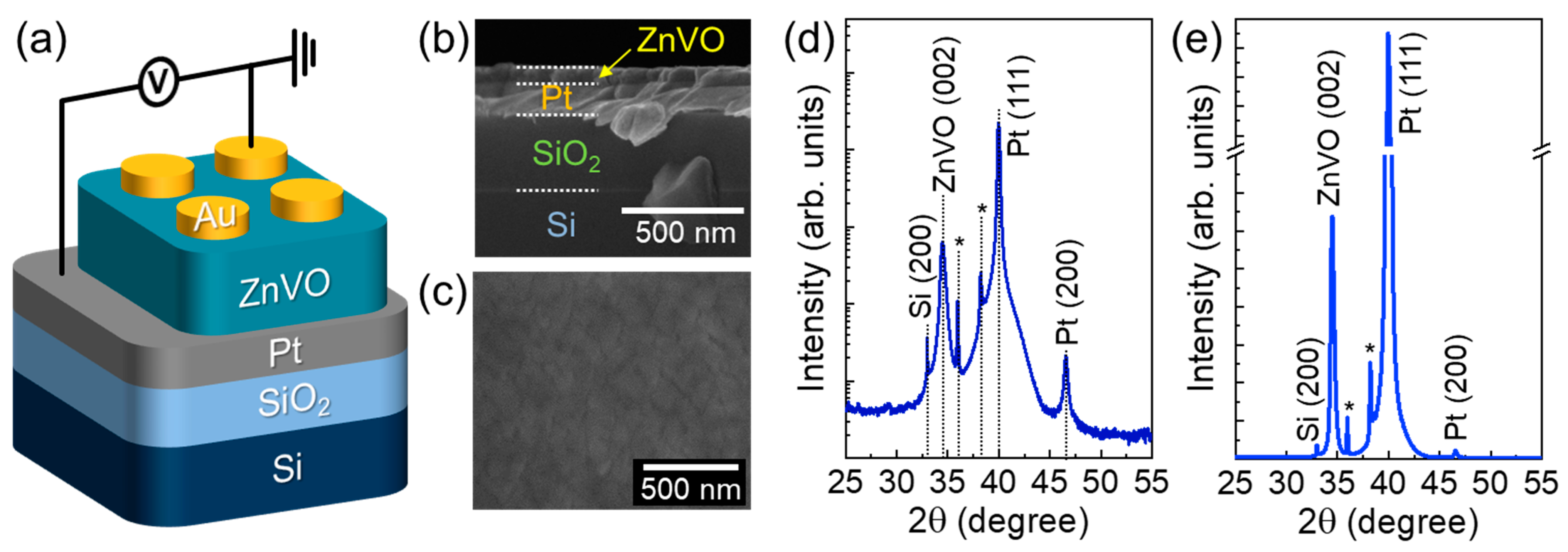
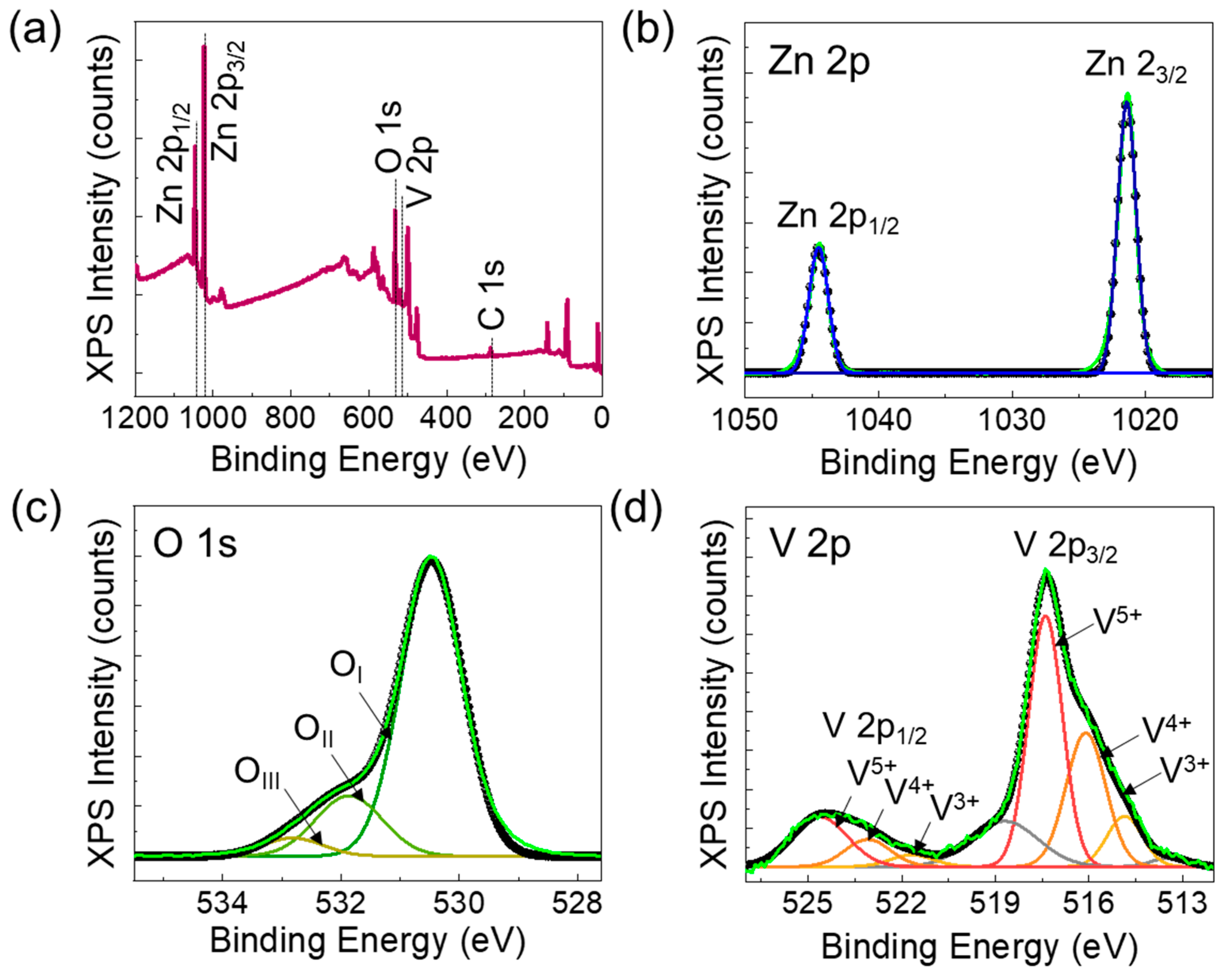

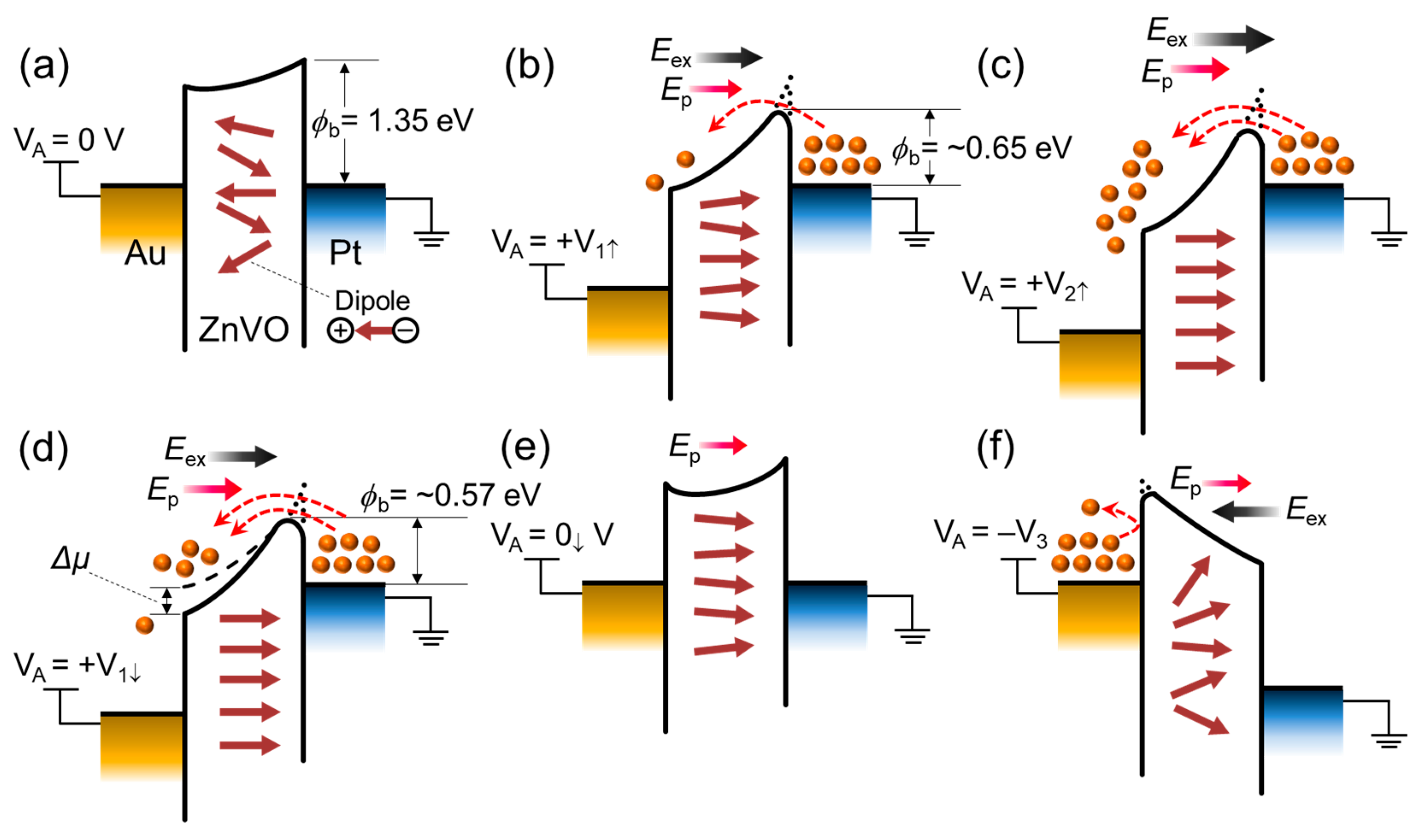
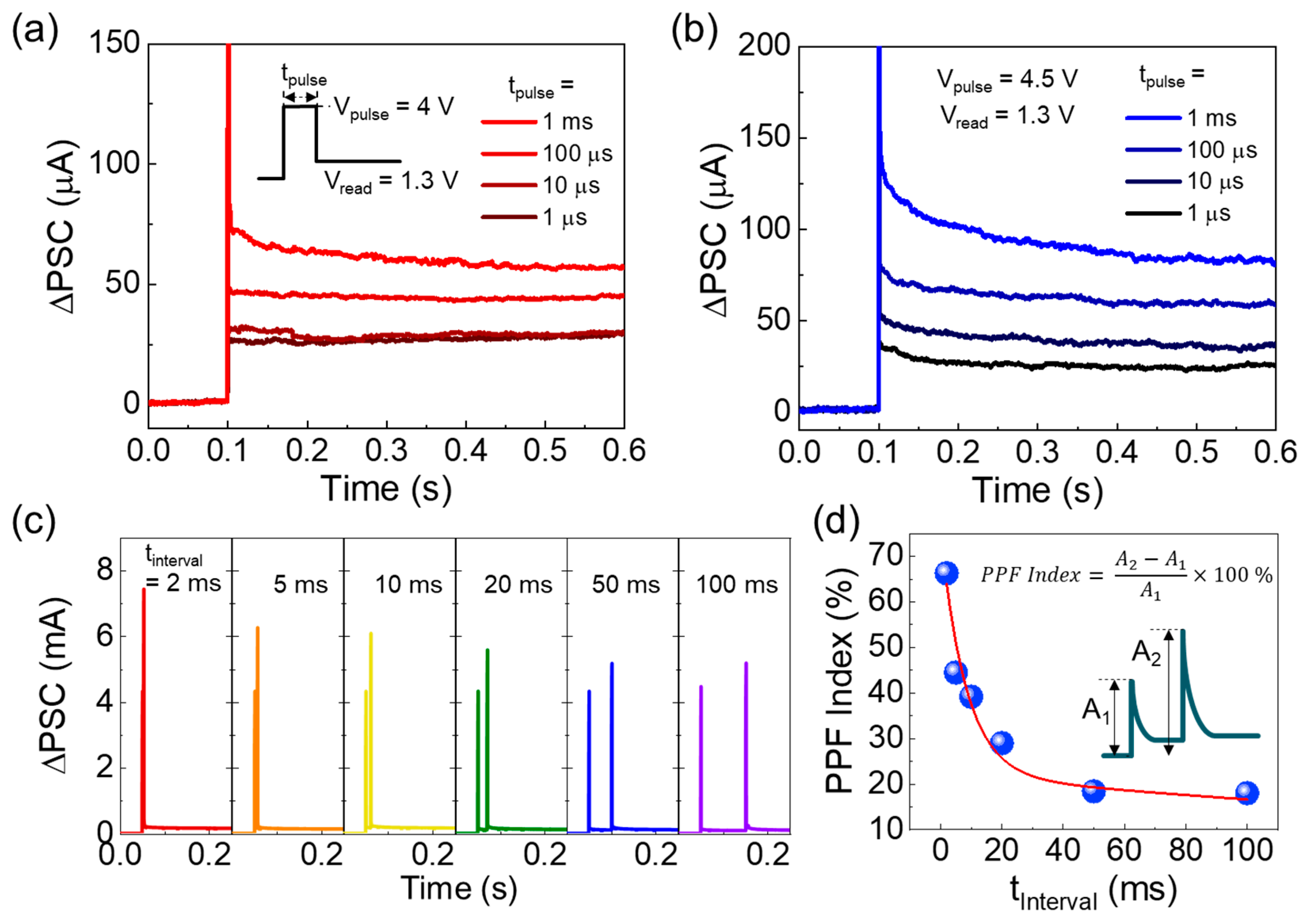

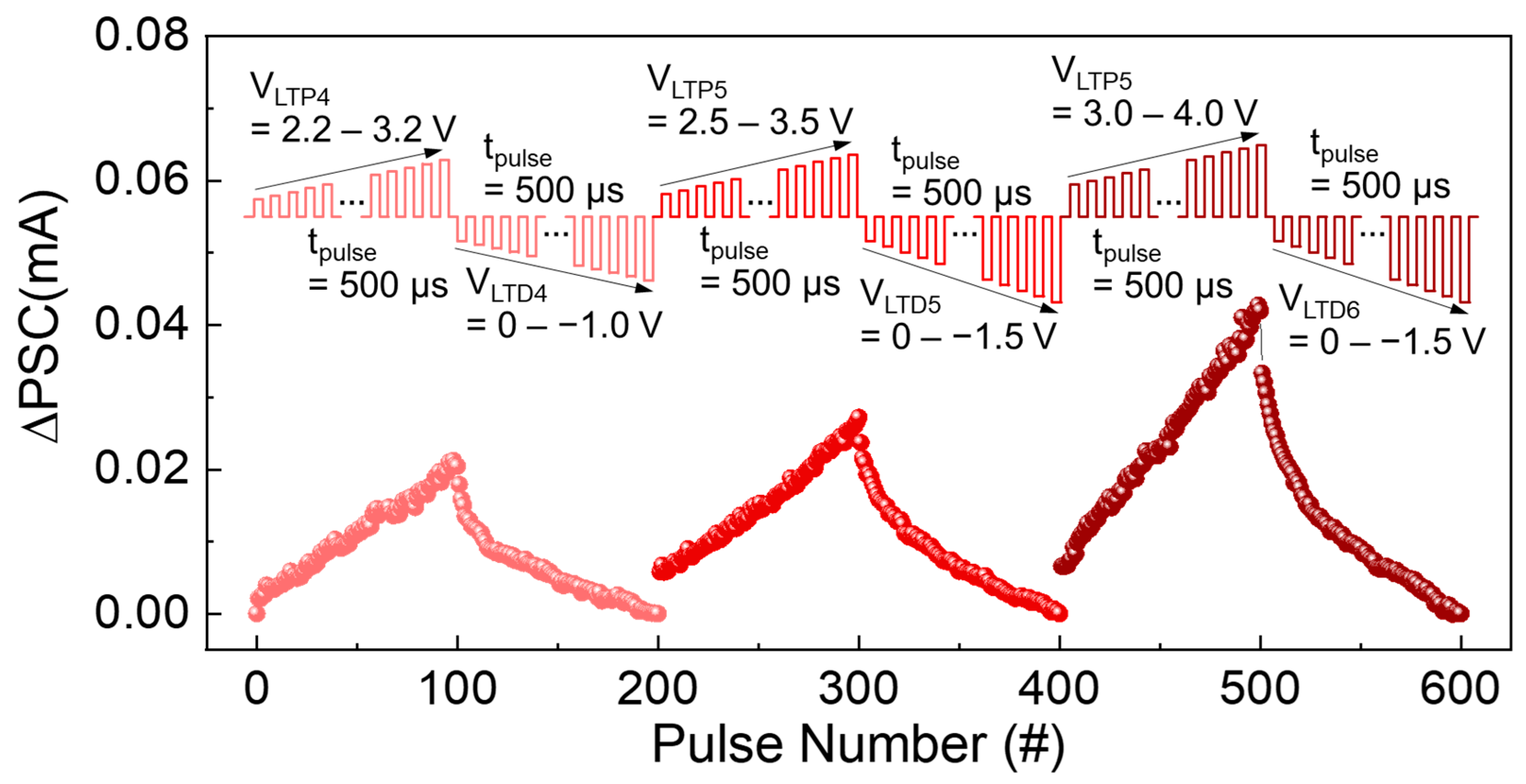

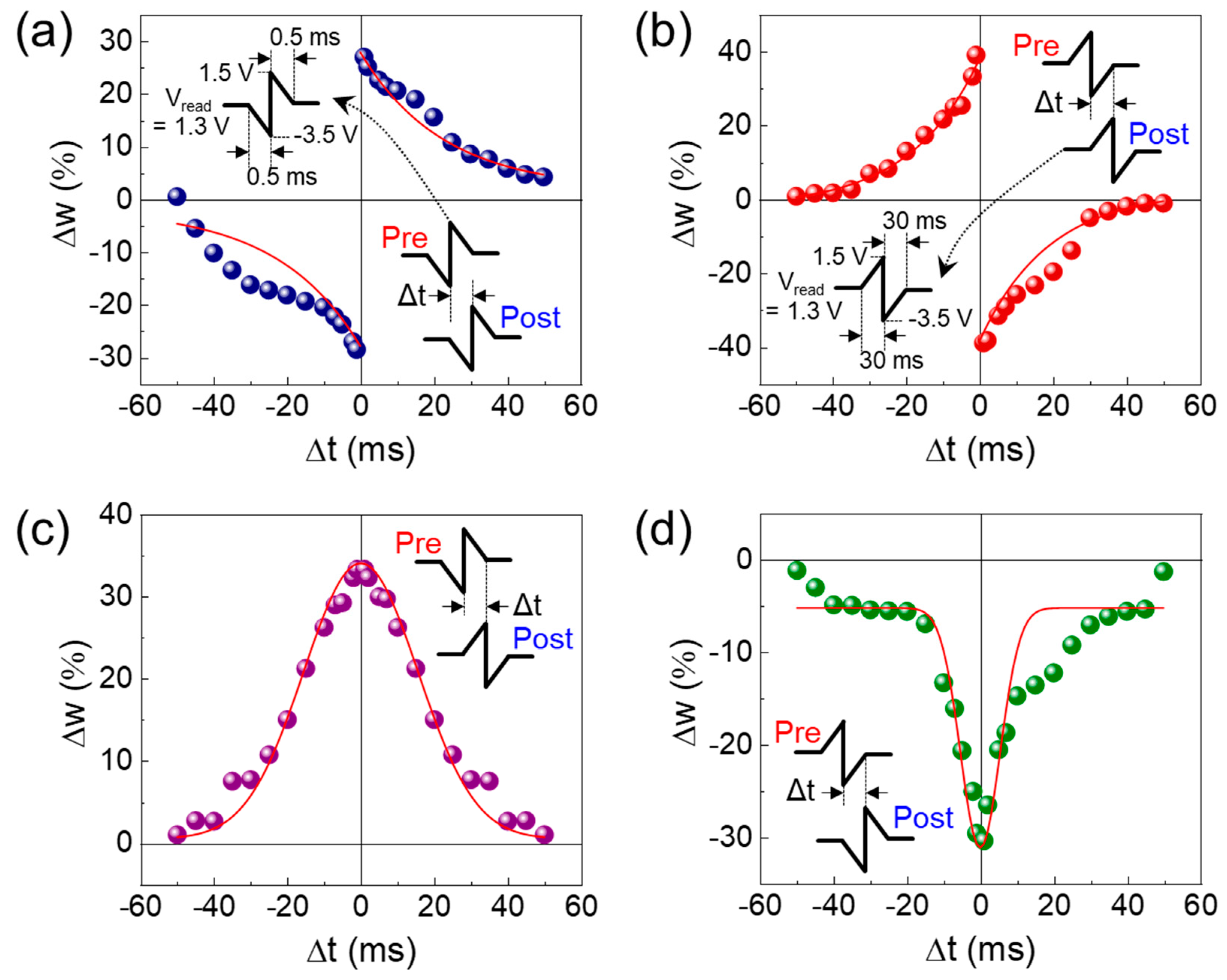
Disclaimer/Publisher’s Note: The statements, opinions and data contained in all publications are solely those of the individual author(s) and contributor(s) and not of MDPI and/or the editor(s). MDPI and/or the editor(s) disclaim responsibility for any injury to people or property resulting from any ideas, methods, instructions or products referred to in the content. |
© 2024 by the authors. Licensee MDPI, Basel, Switzerland. This article is an open access article distributed under the terms and conditions of the Creative Commons Attribution (CC BY) license (https://creativecommons.org/licenses/by/4.0/).
Share and Cite
Lee, Y.; Hong, C.; Sekar, S.; Lee, S. High-Performance Memristive Synapse Composed of Ferroelectric ZnVO-Based Schottky Junction. Nanomaterials 2024, 14, 506. https://doi.org/10.3390/nano14060506
Lee Y, Hong C, Sekar S, Lee S. High-Performance Memristive Synapse Composed of Ferroelectric ZnVO-Based Schottky Junction. Nanomaterials. 2024; 14(6):506. https://doi.org/10.3390/nano14060506
Chicago/Turabian StyleLee, Youngmin, Chulwoong Hong, Sankar Sekar, and Sejoon Lee. 2024. "High-Performance Memristive Synapse Composed of Ferroelectric ZnVO-Based Schottky Junction" Nanomaterials 14, no. 6: 506. https://doi.org/10.3390/nano14060506
APA StyleLee, Y., Hong, C., Sekar, S., & Lee, S. (2024). High-Performance Memristive Synapse Composed of Ferroelectric ZnVO-Based Schottky Junction. Nanomaterials, 14(6), 506. https://doi.org/10.3390/nano14060506






